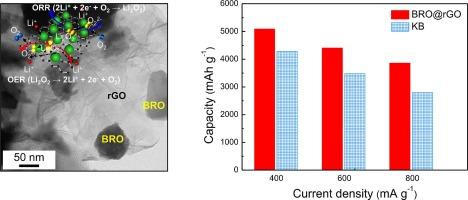Bi-functional hybrid catalysts of pyrochlore Bi2Ru2O7 nanoparticle-reduced graphene oxide nanosheet composites for a lithium-oxygen battery cathode
IF 5.9
3区 工程技术
Q1 CHEMISTRY, MULTIDISCIPLINARY
Journal of Industrial and Engineering Chemistry
Pub Date : 2025-04-19
DOI:10.1016/j.jiec.2025.04.036
引用次数: 0
Abstract
For the development of rechargeable lithium-oxygen (Li-O2) batteries, it has been necessary to solve the issue of sluggish kinetics of both oxygen reduction reaction and oxygen evolution reaction. A bi-functional hybrid catalyst composed of pyrochlore Bi2Ru2O7 nanoparticles (BRO NPs) and reduced graphene oxide (rGO) sheets was prepared and its catalytic properties were investigated for application in Li-O2 batteries. As-prepared BRO NPs anchored on rGO composites (BRO@rGO) in O2-electrode exhibited high initial discharge capacity (ca. 6022.8 mAh g−1). Additionally, the BRO@rGO electrode showed lifetime stability over 56 cyclings with a lower over-potential of 1.15 V at a current density of 200 mA g−1 when the charge/discharge capacity was limited to 500 mAh g−1, as compared with BRO NPs and ketjenblack carbon. This improved performance proves that this composite material of pyrochlore BRO NPs with rGO nanosheets can be promising ORR/OER catalysts for the development of Li-O2 batteries.

焦绿石Bi2Ru2O7纳米颗粒-还原氧化石墨烯纳米片复合材料的锂氧电池正极双功能杂化催化剂
对于可充电锂氧(Li-O2)电池的发展,必须解决氧还原反应和氧释放反应动力学缓慢的问题。制备了一种由焦绿石Bi2Ru2O7纳米颗粒(BRO NPs)和还原氧化石墨烯(rGO)片组成的双功能杂化催化剂,并研究了其在Li-O2电池中的催化性能。在o2电极中,固定在氧化石墨烯复合材料(BRO@rGO)上的制备的BRO NPs具有高的初始放电容量(约6022.8 mAh g−1)。此外,与BRO NPs和ketjenblack carbon相比,BRO@rGO电极在200 mA g−1的电流密度下,当充放电容量限制在500 mAh g−1时,其寿命稳定性超过56次,过电位较低,为1.15 V。这一改进的性能证明,这种由焦绿盐BRO NPs与还原氧化石墨烯纳米片组成的复合材料有望成为Li-O2电池发展的ORR/OER催化剂。
本文章由计算机程序翻译,如有差异,请以英文原文为准。
求助全文
约1分钟内获得全文
求助全文
来源期刊
CiteScore
10.40
自引率
6.60%
发文量
639
审稿时长
29 days
期刊介绍:
Journal of Industrial and Engineering Chemistry is published monthly in English by the Korean Society of Industrial and Engineering Chemistry. JIEC brings together multidisciplinary interests in one journal and is to disseminate information on all aspects of research and development in industrial and engineering chemistry. Contributions in the form of research articles, short communications, notes and reviews are considered for publication. The editors welcome original contributions that have not been and are not to be published elsewhere. Instruction to authors and a manuscript submissions form are printed at the end of each issue. Bulk reprints of individual articles can be ordered. This publication is partially supported by Korea Research Foundation and the Korean Federation of Science and Technology Societies.

 求助内容:
求助内容: 应助结果提醒方式:
应助结果提醒方式:


